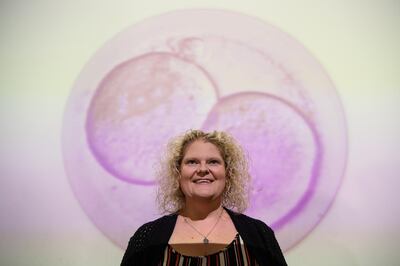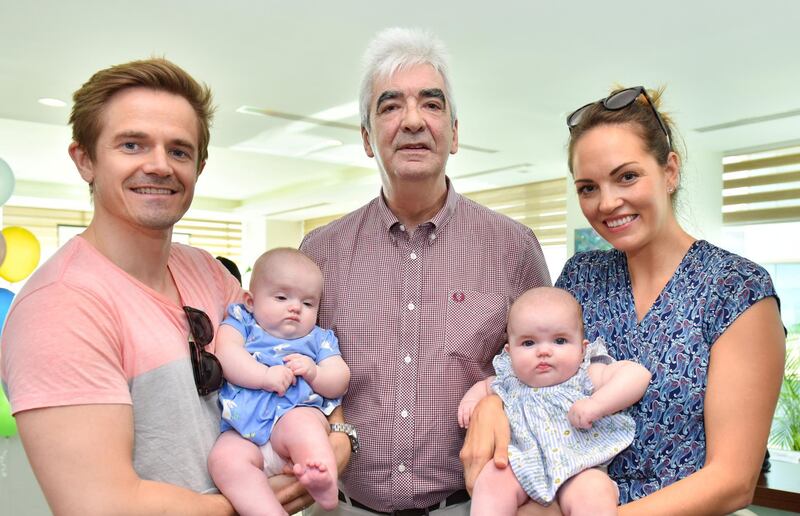In ordinary circumstances, British mum-of-two Louise Brown’s fortieth birthday would be an unremarkable affair.
But this week her special day will be celebrated across the world because her birth on July 25, 1978 marked a medical breakthrough that gave childless couples an opportunity to become families.
Ms Brown was the world’s first baby to be born through in vitro fertilisation (IVF), a technique that was developed by Cambridge physiologist Robert Edwards and obstetrician Patrick Steptoe from Oldham General Hospital.
The two physicians later established the first IVF clinic named Bourn Hall in Cambridgeshire, which went on to create thousands of new lives through the process of fertilising a woman’s eggs outside the body, then returning the embryo back into her womb to develop.
Thousands of IVF clinics now exist across the world including in the UAE, which has seen a surge in demand for the treatment with an estimated 30 to 35 per cent of couples in the country believed to have some form of fertility problem.
Bourn Hall Fertility Centre in Dubai, which is affiliated with the inventors of IVF in the UK, threw a party this week to celebrate Ms Brown’s birthday, inviting parents and children, who had been born with the help of specialists at the clinic.
Dr David Robertson is the group medical director at the centre and underwent his initial training in IVF under the direction of the original Bourn Hall team in the UK before moving to the UAE in 2006.
“We celebrate Louise’s birthday every year in a minor way. But 40 is symbolic,” Dr Robertson tells The National.
“A fortieth birthday is always seen as being a big milestone. In terms of the technology of IVF, it’s an indication of how long the practice has been developed and how much it has come of age."

Seen as controversial in 1978, IVF treatment is now an accepted and widespread option for couples desperate to conceive.
Infertility issues have increased in both men and women in the Middle East. The rise in obesity in both men and women as well as waiting until later in life to have children are major factors in declining birth rates.
But while discussing fertility problems openly used to be taboo, Dr Robertson has seen a seismic shift in attitudes across the region since he qualified in 1986.
“Where I see the biggest change is with men. I spent a couple of years in the Gulf back in the 1980s and if I asked a man to do a sperm test then, they would simply refuse. It was seen as a woman’s problem. In general, men now are much more open to participating.
“This is important because in 50 per cent of the couples that we see, there is a male factor involved. It is very common in this region because there is a long history of consanguineous marriage and genetic issues that stem from this.”
For thousands of couples seeking costly fertility treatment every year - the number in Dubai is expected to almost double from 5,975 in 2015 to 9,139 by 2030, with population growth - it is important to choose a clinic that is right for them.
Dr Robertson advises people to do their homework and go for two or three consultations before shelling out thousands of dirhams for one cycle of treatment. Feeling comfortable and well looked after is imperative, as is finding a clinic where the specialists have experience in the field.
He also warns couples to look carefully at success rates advertised by clinics and whether these rates are of live births or positive pregnancy tests. A lack of restrictions on marketing in the UAE can often lead to the spread of inaccurate information.
_______________
Read more:
Women permitted to freeze embryos in major changes to UAE health regulations
IVF doctors say poor lifestyle and late marriage to blame for UAE fertility issues
UAE medics see infertility rise driven by lifestyle diseases and late marriages
_______________
“You should look at success rates but you should be clear about what you are getting,” he explains.
“For example, a lot of women doing fertility treatments might have a positive pregnancy test but then they might miscarry so the number of live births is smaller. I could advertise a pregnancy rate as 70 per cent but that would be very misleading.”
Despite working in the field for almost as long as the technique has been around for, it is still a joyous moment for Dr Robertson when he helps a couple conceive a child.
“Even to this day it is amazing when you look at what happens in the laboratory with embryos developing and to then see a little baby at the end of the pregnancy,” he says.
“It still gives a tremendous buzz to all of us.”






